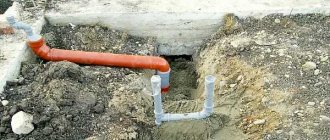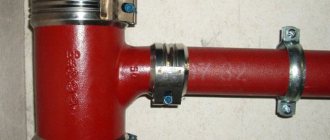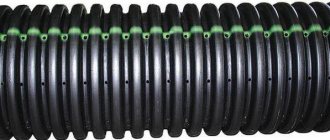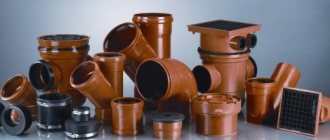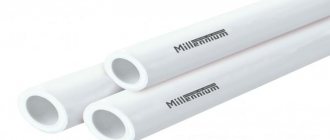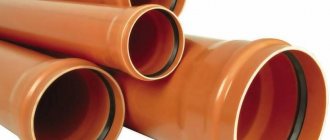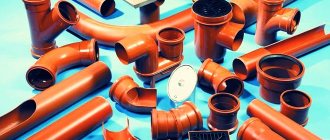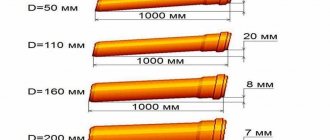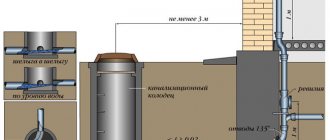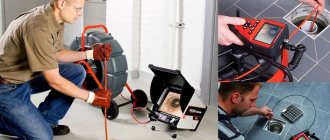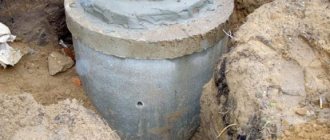Previously, exclusively cast iron sewer pipes were used for external and internal sewerage networks. And in our time, despite the increasing use of polymer pipes, metal products are still in demand when laying pipelines.
Reliability is a distinctive feature of cast iron pipes
Types of cast iron pipes and their applications
Cast iron is an alloy of iron with carbon additives. In order for an alloy to be called cast iron, its carbon content must be at least 2.14%. Iron alloys with a smaller proportion of carbon are steel.
There are several types of cast iron pipes, which are made from iron alloys with varying degrees of carbon content. Moreover, carbon varies not only in its fractional content, but also differs in structure. It can be round graphite, lamellar, chemically bonded carbon. In addition to carbon, aluminum, bismuth, nickel, chromium, manganese, sulfur, phosphorus, and silicon are added to the alloy to give the alloy certain chemical and physical properties.
Note! The high proportion of carbon in an iron alloy gives it increased rigidity and brittleness, reducing ductility. In terms of chemical properties, one can note increased resistance to aggressive influences, which significantly increases the service life of cast iron pipes (compared to steel counterparts).
The scope of application of cast iron pipe products remains quite wide, since for some operational characteristics these products have no equal analogues.
The main areas of use are:
- industrial pipelines for transporting aggressive liquids and petroleum products;
- construction of sewerage and drainage systems at industrial facilities and multi-storey residential buildings;
- installation of fire protection systems;
- heating and water supply.
In individual houses, they are rarely used for laying sewers, since there are no increased requirements for the strength of communications.
Cast iron pipes have the following performance characteristics:
- warranty service life 80 years;
- the minimum operating temperature reaches -60 degrees;
- withstand impacts from the internal environment with a force of 550 N/mm²;
- can be buried in the ground to a depth of 10 m;
- have the property of absorbing noise and vibration.
We recommend that you familiarize yourself with: Manufacturing technology of profile pipes
Note! An important advantage is the possibility of installation without the use of fittings, not only in straight sections. Long runs can be laid in an arc, connecting the pipeline segments into a socket.
The following types of cast iron pipes are distinguished:
- CHK – cast iron sewer, non-pressure. The composition of the alloy, in addition to carbon in plate form, includes silicon.
- VShChG – high-strength cast iron, pipes are designed for operation under conditions of high pressure, pressure.
- SML – cast iron pipe products without socket, an alloy with a high carbon content.
- ChNR - the abbreviation stands for “cast iron, pressure, socket”.
Gravity
Non-pressure cast iron pipes are used when laying indoor and outdoor sewerage systems in systems that operate by gravity. These are the materials that were used for sewer lines in residential buildings. Their advantage is noiselessness, the ability to combine with plastic pipes, and the possibility of reuse with careful dismantling. These are quite fragile products that cannot withstand shock loads.
High strength
High-strength cast iron is used for the construction of pipelines that operate under pressure for transporting aggressive liquids. A special feature of these materials is their resistance to force and impact loads. They are stronger than steel pipes. Their service life reaches 100 years or more.
Such strength of pipe materials made of VShChG cast iron is explained by the peculiarity of the alloy. It contains graphite in a spherical form, which gives the alloy a plasticity uncharacteristic of cast iron. Pipes are produced with a socket and rubber gaskets. In addition to industrial production, they are used for laying external sewerage in unfavorable conditions - at great depth, at extremely low temperatures, under highways.
Socketless
Pipe products that require special clamps for installation. To make socketless cast iron pipes more corrosion resistant, they are coated inside and outside with a special compound containing epoxy resin. The scope of application of these products is drainage systems in enterprises using aggressive media and water supply.
We recommend that you read: Installation of internal and external sewerage systems in a private house
For the installation of water pipes, socketless cast iron pipes have no equal. These are environmentally friendly pipelines with high throughput that can withstand any temperature and its changes. According to statistics, such water supply systems have the longest trouble-free service life.
Flared pressure
During production, these pipes are coated with a special bitumen-based composition, which gives them additional resistance to aggressive influences.
Assembly of sewerage system pipelines
Connection cast iron - cast iron
For ease of installation of pipelines, cast iron socket sewer pipes are widely used.
Connection of two cast iron pipes
Assembly of cast iron pipes includes the following steps:
- The straight part of the cast iron pipe is inserted into the socket of an already installed pipe.
- The resulting gap between the inside of the socket and the outside of the pipe must be caulked with tarred tow. The tow is driven in with a wooden spatula using a hammer until 2/3 of the socket is filled.
- 1/3 is filled with sealant without impregnation (impregnation impairs adhesion to cement).
- The socket is filled with a cement solution (grades 400 or 300). In this case, the proportion of water to cement is used as 1 to 9. Instead of cement mortar, asbestos-cement mortar can be used (asbestos-cement fibers and cement in a ratio of 1 to 2).
- The solution is compacted and a wet rag is placed on top to prevent cracks from appearing before it dries.
Installation of cast iron pipes in stages
When driving in tow, care must be taken to ensure that individual strands do not fall inside the pipe. Foreign objects inside the pipeline lead to blockages.
The connection between cast iron pipeline parts must be tight. The quality of the joint can be improved by using silicone sealant instead of cement mortar. But the cost of the sealant significantly exceeds the cost of the solution, which increases the cost of installation.
Connection cast iron - plastic
To connect a sewer pipe made of cast iron with a pipe made of polymer, an adapter and silicone sealant are used. The sealant is applied to the inside of the socket of the cast iron pipe (to fill the roughness and improve adhesion). Then silicone sealant is applied to the transition and installed in the socket.
Connection cast iron - plastic
Dimensions of cast iron pipe products
Pipe products made of cast iron are characterized by the following dimensional parameters:
- product wall thickness;
- nominal bore (not to be confused with internal section);
- external diameter.
The weight of a linear meter of a product is not used as a characteristic of a cast iron pipe, since it varies depending on the size and type.
The official document that regulates the production of non-pressure pipe products made of cast iron is GOST 6942-98. According to this document, products are produced in three external diameters - 50, 100 and 150 mm.
To regulate the production of pressure pipes, GOST 9583-75 is used. According to it, pipes with a nominal bore from 65 to 1000 mm are manufactured.
Based on wall thickness, pipes are divided into 3 classes marked A, B, LA. These characteristics are systematized in special tables.
Due to the high mass of products, cast iron pipes are produced in segments from 0.75 m to 6 m in length.
Note! When specifying the length of the product, the socket is not taken into account.
Repair of cast iron pipes
If the pipe material is damaged (chip, crack), repairs become necessary.
To repair a crack, it is necessary to cut the edges, deepen them with a scraper and degrease them. Then the recess is sealed with the mixture.
1 mixture option:
- copper oxide (powder) – 1.5 parts;
- orthophosphoric acid – 1 part.
Mixture option 2:
- iron filings – 2.5 kg;
- ammonia (powder) – 60 g;
- sulfur – 30g;
- water (until the consistency of a thick dough).
To repair damage with leaks, rubber gaskets (2 - 3 pcs.) are used. They are pressed against a cast iron pipe with metal plates. Rubber gaskets with plates are pressed with hoops using bolts or twisted with wire and tightened with pliers.
Cast iron pipe bandage
Marking
When choosing cast iron pipe products, you should pay attention to their markings, which indicate all the parameters of the pipe, starting with its type, namely:
- type of product;
- production standard;
- length;
- conditional capacity.
For example, the marking ТЧК-150-2000 GOST 6942-98 designates a bell-shaped non-pressure product with a diameter of 150 mm and a segment length of 2 meters.
Advantages and disadvantages
The popularity of cast iron pipes for sewer installation is explained by their high wear resistance. The main positive qualities of communications include:
- long trouble-free service life, which reaches up to 100 years;
- environmental safety;
- noiselessness;
- possibility of installation in any soil without the use of additional protective boxes;
- possibility of installation at great depths;
- possibility of combination with modern plastic pipes;
- low cost of maintenance of communications after commissioning;
- resistance to temperature changes and low temperatures;
- a wide range of installation possibilities - socket connections, welding, using fittings or special clamps.
We recommend that you read: How to build a plasterboard box yourself to disguise pipes in a toilet?
The disadvantages of cast iron sewer pipes include:
- fragility;
- heavy weight;
- high cost.
Note! The fragility and heavy weight of cast iron pipes make them difficult to install and transport independently. When purchasing sewerage products for an individual home, you should choose pipes with a thin wall.
Cast iron socket products of class A or LA have sufficient strength for an individual sewer system.
How is caulking done?
Installation of cast iron sewer pipes is a complex and lengthy procedure. Each connecting element has to be processed separately, which slows down the assembly of the line. It is impossible to shorten or speed up the process, although experienced installers can work quite quickly. High speed is achieved by optimizing working time, using your own skills and experience.
Features of installation of cast iron sewerage (cast-iron-cast-iron connection):
- the pipe socket is put on the free end of the previously laid line;
- tow or a strand of resin is stuffed (caulked) into the gap between the walls of the socket and the free end of the other part. It is compacted with a special tool - a wooden spatula. Stuffing is done until the tow fills 2/3 of the height of the connecting element;
- the packing is treated with a sealant. It must be without impregnation so that the quality of adhesion of tow to cement does not deteriorate;
- the remaining free third of the socket is filled with cement mortar (in a proportion of 9 parts cement to 1 part water). Sometimes the solution is reinforced with asbestos-cement fibers in half the proportion;
- the solution is poured into the gap and compacted. Place a wet rag on top. So that cracks do not appear during hardening.
When assembling lines, cement mortar has recently been replaced with sealant. This speeds up the installation process, since the operation of mixing the solution is eliminated. However, the cost of modern materials is much higher than the price of cement, which increases the cost of constructing a drainage network.
Installation of a sewer system made of cast iron pipes
For installation of sewerage inside the house, socket-type non-pressure products with a diameter of 50 or 100 mm are used. For laying external communications, the pipe diameter increases to 150-200 mm. However, these dimensions are not a rigid norm and vary depending on the purpose of the sewer system and the expected throughput load.
Vertical installation of sewer sections is carried out in a socket, assembling the structure from the bottom up. To seal the joints, use internal rubber gaskets and additionally seal the joint with mortar or a special sealant (construction sealant dries faster). The solution is left for a day to dry, after which a test launch of communications is carried out.
Note! Pipes and fittings manufactured before 1974 are not standardized and may differ in size from newer ones. Currently, cast iron pipes and fittings are produced according to international standards.
For installation of turns, wiring, revisions, appropriate fittings are used, which can be bell-shaped or smooth. Plumbing manufacturers offer a large selection of tees, crosses, bends, and adapters for cast iron pipelines.
Fastening of cast iron communications is carried out on special supports, to which the pipes are attached with circular clamps and brackets.
